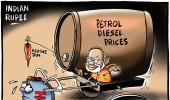'The question often being asked is whether the demand for petrol and diesel is price inelastic?' asks Arun Balakrishnan, former chairman and managing director, Hindustan Petroleum.

Fuel prices are the rage in all types of media -- the press, television -- and even when folks get together for a cup of tea.
The middle-class budget is being seriously eroded with OPEC's unity in cutting production to fill its coffers.
Everyone knows that a good part of the price you pay per litre of petrol and diesel is pocketed by the central government in the form of Excise Duty/Cess and by state governments in the form of Value Added Tax (VAT); the larger share going to state governments thanks to taxes being levied ad valorem by them.
Even the folks at OPEC have figured this out and say we guys make more money per ton of crude oil by levying taxes than they do in extracting it from their mother sands and selling it to us.
The question often being asked is whether the demand for petrol and diesel is price inelastic?
Meaning, can the oil companies keep on increasing the price without having any impact on the demand?
Many years ago, in the now banished organisation called the Oil Coordination Committee (an oil industry think-tank), a study was done to measure the price elasticity of mass consumption fuels like petrol and diesel.
The study concluded that demand for petrol and diesel is inelastic if the changes in price is within a range of acceptability.
This range of acceptability may vary with the value of the rupee, inflation, GDP growth, etc.
If the price change is beyond this range, the demand changes perceptibly.
But most likely in the short run.
There was a time in the 1990s, when oil prices were fully government controlled.
They called it the Administered Pricing Mechanism or APM.
Even diesel prices were subsidised as governments were weary of the public reaction to price increases and its impact on inflation.
With all these subsidies, the Oil Economy Budget had become negative, and the government's foreign exchange coffer was almost empty with very little cushion to buy more crude oil.
A bold decision was taken to increase the price of all petroleum products by 25% overnight.
There was shock and awe across the country as nobody had seen anything like this before.
But the government of the day got away with it without a murmur from the public as the impending disaster of a foreign exchange crisis resulting in gold from the Indian treasury being carted away to a foreign country as security for a loan was in the public domain.
The demand for petrol and diesel crashed, but only for a few weeks. Within a few months, it came back to the then average growth of six to seven percent.
Then, GDP growth was India's favourite 3.5% and to sustain that level of growth fuel consumption had to grow by double that number.
Life came back to normal as the months passed by.
What was then the Foreign Exchange Crisis is today the Pandemic.
And the quantum of additional duties and taxes is not much different from what it was then.
The murmurs are likely to quieten as the fuel consuming public readjust their budgets and get along with their lives.
So far, so good.
The seasons have changed, and summer has set in warming up the entire nation.
This is the time when all of us scan the newspapers to find out what the weather mandarins have to say about the impending monsoon.
If it is likely to be a good one, then all is well.
If not?
To answer this question, I must recall another OCC study on demand for diesel in a drought year.
According to that study, in a drought year the demand of diesel for agriculture use increases by about 300% or three times the normal requirement.
Diesel is used for pumping water for irrigation and rice cultivation requires a lot of water.
Electricity for agriculture is free in Punjab and subsidised in Haryana and Western Uttar Pradesh, the states where the belligerent farmers come from.
With limited hydropower generation and limited upside to thermal power production, poor rains can result in large scale power outages across these regions during the sowing season.
Farmers then take their tractors loaded with 200 litre drums to oil company retail outlets to buy diesel.
Unlike state governments, the oil companies are not altruistic to give away diesel free to the kisans.
And these burly gentlemen farmers are not going to like it one bit if their fuel expenditure goes up three times when diesel prices are in the Rs 100 per litre range.
That too in a year that they are physically and mentally worn out after sitting at the ice-cold borders of the country's capital and must now brace themselves for the searing north Indian summer.
And especially when the government has an eye on their favourite freebie called the Minimum Support Price or MSP.
Or will they be sensible enough to take the hint from Ashok Gulati and go for alternate crops that are less dependent on water?
The phones in heaven will soon start ringing and God will have a lot to do to keep his creations in good humour.
*Kindly note the image has been posted only for representational purposes.
Feature Presentation: Ashish Narsale/Rediff.com











